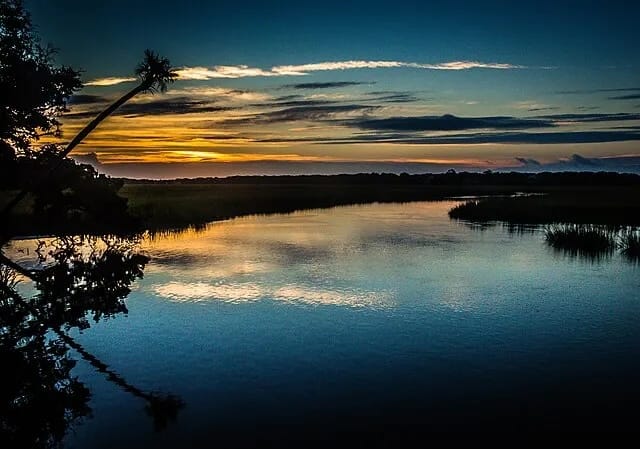This story came from research on another subject which wasn’t ripe for publication as the Supreme Court might say. That story was about the fire that destroyed the home of a Jewish circuit court judge in South Carolina who has been verbally attacked by Donald Trump for blocking handing over private voter information data to the federal government. Judge Diane Goodstein previously received multiple death threats and now her home is destroyed. I’ll wait until there is a determination as to whether the fire was accidental or arson before writing on that. My preliminary research led me to this story about Goldstein’s community of Edisto Beach which at the last census had only two Black residents after once being over 90% Black. I wanted to know why.
Edisto Beach is a small section on the southern tip of Edisto Island. The first known inhabitants of Edisto Island were Indigenous peoples, specifically the Edistow (or Edisto) Indians, a sub‑tribe of the larger Cusabo group who lived along the South Carolina coast. Archaic cultures (as early as 2000 B.C.): Archaeological evidence shows Native peoples lived seasonally on the Sea Islands, leaving behind shell middens (large piles of oyster and clam shells) that still exist today. Edistow / Edisto people (1500s): By the time Europeans arrived, the Edistow were cultivating crops, fishing, and trading with inland tribes like the Catawba. They spoke a language now lost, but were part of the Cusabo confederation, which included several coastal tribes. The last American Community Survey from 2019–2023 doesn’t indicate any inhabitants of Edisto Beach are descendents of the original peoples.
During slavery (1700s–1860s), enslaved Africans brought from the “Rice Coast” of West Africa (Senegal → Sierra Leone → Liberia) were forced to work the rice, indigo, and later cotton plantations on Edisto Island. By the mid‑19th century, enslaved Africans and their descendants made up over 90% of the island’s population.
After emancipation (1860s–early 1900s), when white planters fled during the Civil War, many freedpeople stayed. Edisto became part of the Port Royal Experiment, where formerly enslaved people farmed land, built schools, and created self‑governing communities. For decades after the war, Edisto Island remained overwhelmingly Gullah‑Geechee, with Black residents owning land and maintaining cultural autonomy.
In the early 20th century, Black families owned much of the beachfront property. Oral histories recall Gullah‑Geechee families fishing, farming, and holding land communally. Beginning in the 1920s–40s, White developers and investors began acquiring beachfront land. Some Black families sold under economic pressure; others lost land through tax sales, partition sales, or discriminatory legal practices.
By the mid‑20th century, Edisto Beach had been transformed into a White‑only resort town, while most Gullah‑Geechee families were pushed inland on Edisto Island or off the island entirely.
The Forces of Displacement incluided Jim Crow segregation: Black residents were excluded from the new beach community, which marketed itself to White vacationers. Land passed down informally within Black families (without wills) was vulnerable to forced sales. Developers exploited this to acquire prime beachfront parcels. Lack of access to loans, infrastructure, and political power made it difficult for Gullah‑Geechee families to hold onto coastal property. Rising land values and taxes further displaced long‑time Black landowners.
In the early 1900s, Edisto Island as a whole was still majority Black, with Gullah‑Geechee communities thriving inland. Today, Edisto Beach (the incorporated town) is 97% White, ~0.2% Black (about 2 people out of 1,000). Edisto Island (unincorporated, inland) still has a significant Gullah‑Geechee population, though declining due to development pressures. Those who remain are fighting hard to preserve their heritage.
The story of Edisto Beach is not simply about shifting demographics; it is about how power, law, and economics combined to erase a people from the very shoreline they once called home. From the Edistow Indians to the Gullah‑Geechee families who built lives in freedom after emancipation, the island’s earliest communities were steadily displaced by waves of colonization, segregation, and development. What remains today is a resort town that markets tranquility and natural beauty, while the deeper history of dispossession lies just beneath the sand.
To acknowledge this history is not to diminish the Edisto Beach of today, but to insist that its past be remembered alongside its present. The near‑erasure of Black residents from a place that was once overwhelmingly African American is not an accident of time, but the result of deliberate policies and practices. If Edisto Beach is to be more than a postcard image of coastal South Carolina, it must also be a site of reckoning — where visitors and residents alike understand that the beauty of the island is inseparable from the struggles of those who were pushed aside. Only then can the story of Edisto be told in full, honoring both what was lost and what still endures.
This post originally appeared on Medium and is edited and republished with author's permission. Read more of William Spivey's work on Medium. And if you dig his words, buy the man a coffee.
